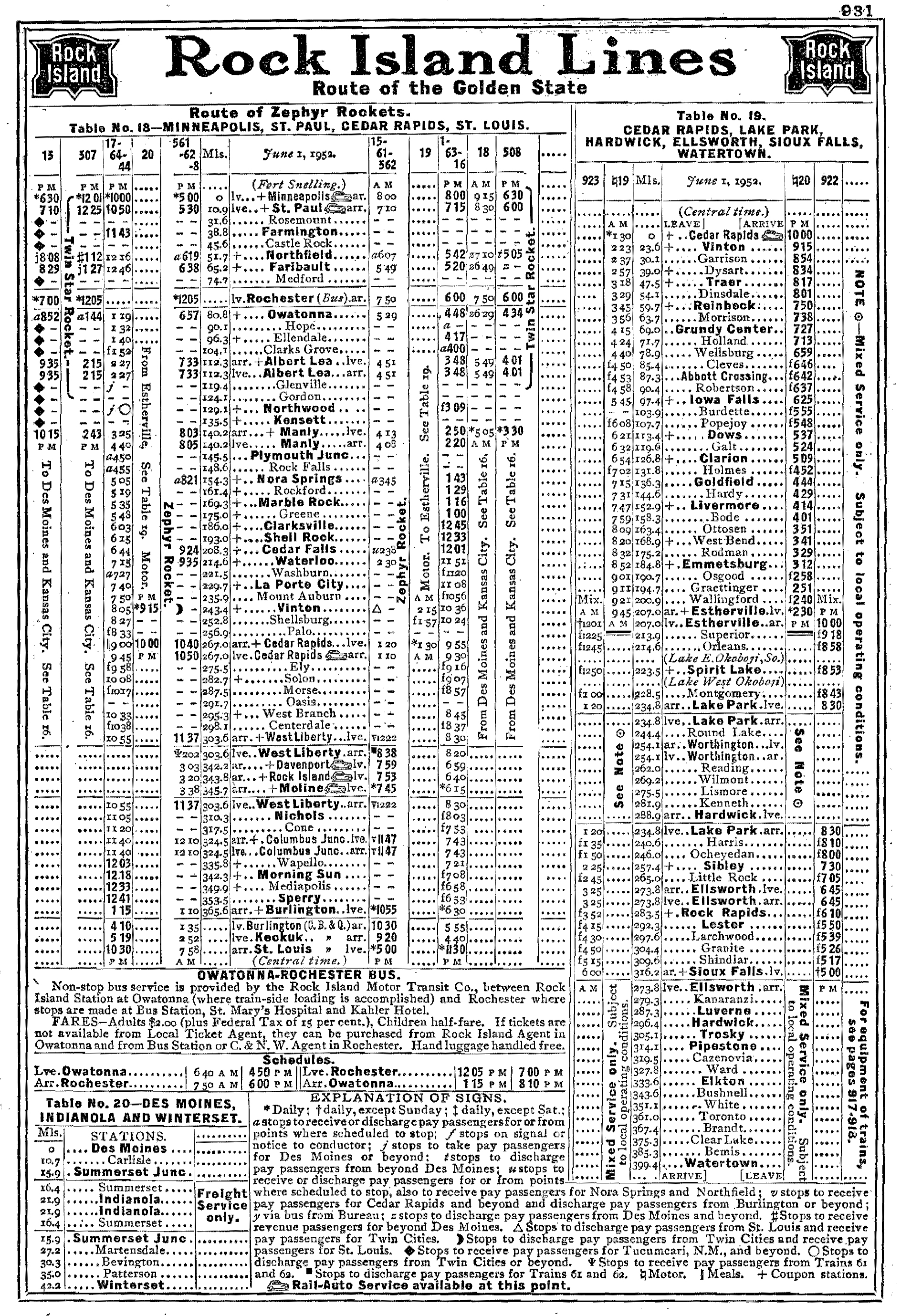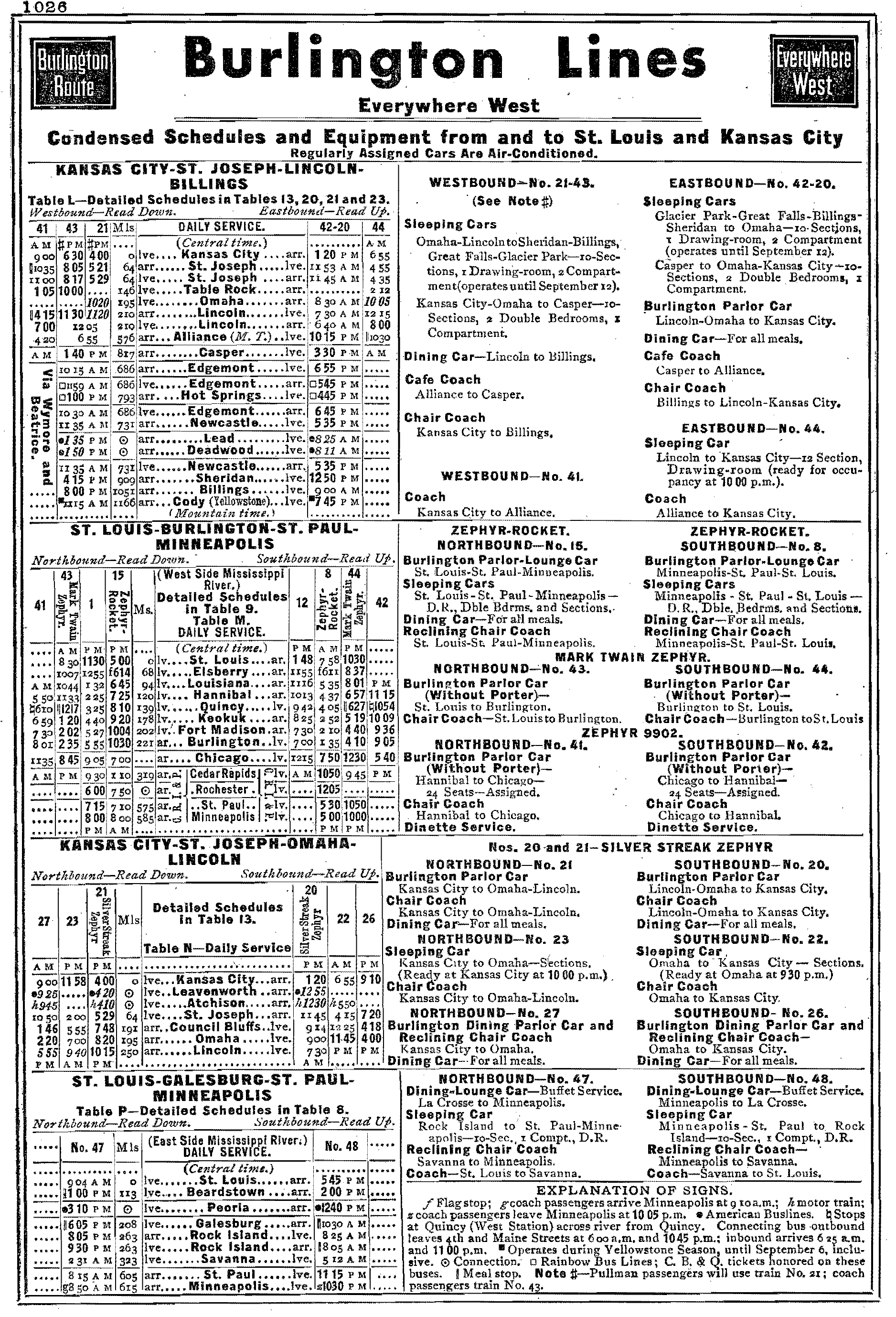"Zephyr Rocket" (Train): Consist, Route, Timetable
Last revised: February 24, 2025
By: Adam Burns
The Zephyr Rocket was an overnight, streamlined passenger train operated by the Rock Island and Chicago, Burlington & Quincy between Minneapolis, Minnesota and St. Louis, Missouri. It ran from 1941 to 1967.
The train's name was a combination of each railroad's premier streamliners, Burlington's "Zephyrs" and the Rock Island's "Rockets." Each system operated entire fleets of streamliners carrying these names, serving the far ends of their networks.
Interestingly, the Zephyr Rocket's unique corridor sustained its success for far longer than most others and it was still earning revenue over its direct costs as late as 1964 for the Burlington.
Photos
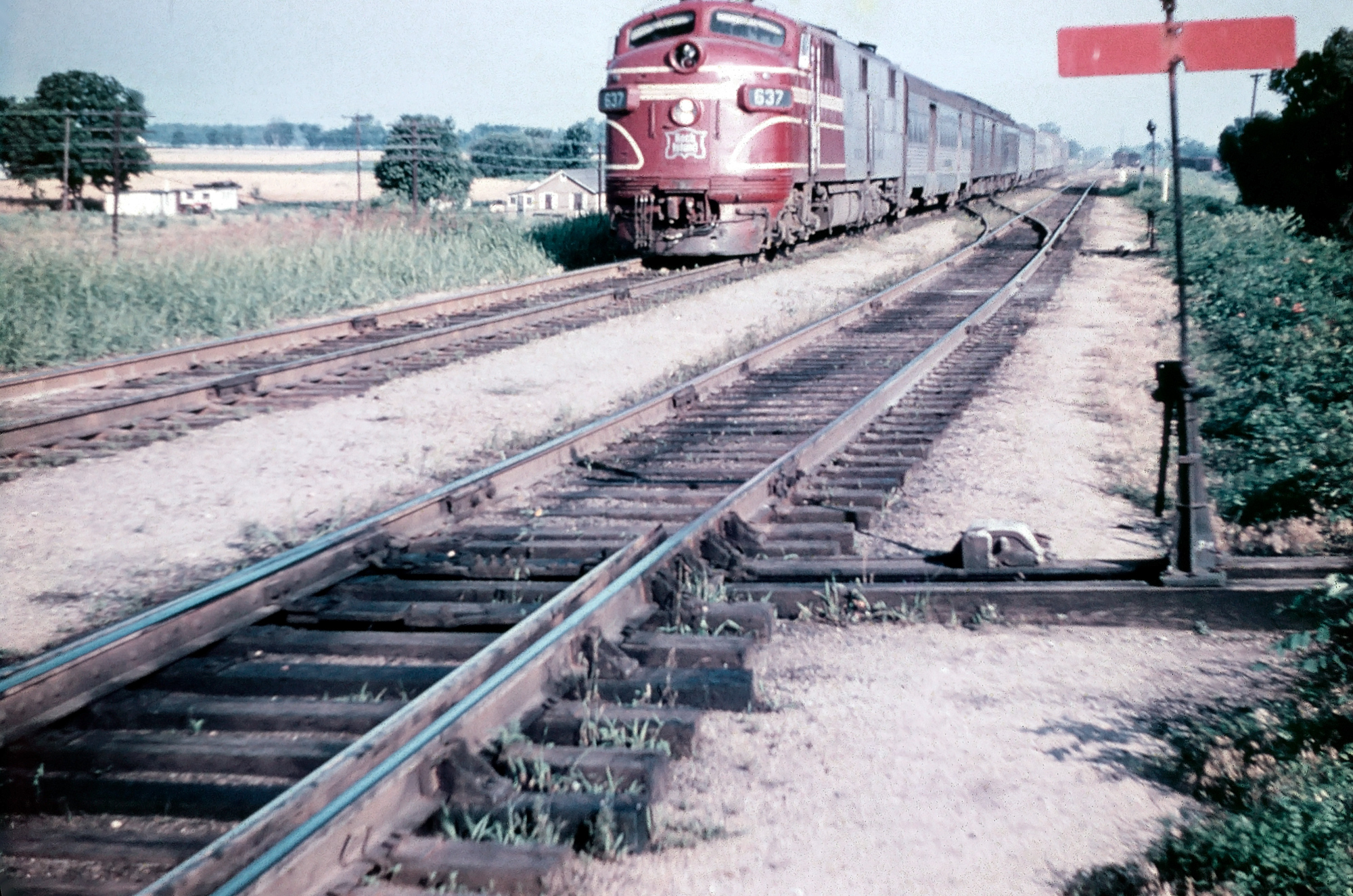 Rock Island E7A #637 has the northbound "Zephyr Rocket" just out of St. Louis traveling over the CB&Q at West Alton, Missouri on the afternoon of June 22, 1957. This was a joint service with the Burlington between St. Louis and the Twin Cities. At the time it still offered a diner over the CB&Q (St. Louis-Burlington), a 6-section/6-roomette/4-double bedroom sleeper, and reclining seat coaches. American-Rails.com collection.
Rock Island E7A #637 has the northbound "Zephyr Rocket" just out of St. Louis traveling over the CB&Q at West Alton, Missouri on the afternoon of June 22, 1957. This was a joint service with the Burlington between St. Louis and the Twin Cities. At the time it still offered a diner over the CB&Q (St. Louis-Burlington), a 6-section/6-roomette/4-double bedroom sleeper, and reclining seat coaches. American-Rails.com collection.History
The Rock Island and Burlington had both already jumped into the streamliner fray when they jointly introduced the Zephyr Rocket on January 7, 1941.
The two railroads had also partnered with services and connections between Fort Worth/Dallas-Houston via the jointly owned Burlington-Rock Island Railroad, notably the Texas Rocket (1937) and Sam Houston Zephyr (1936).
The Zephyr Rocket was one of the most interesting streamliners ever placed into service from a routing standpoint. It served a unique, St. Louis-Minneapolis market; a market offered by no other carrier.
Separately, neither the Rock nor the CB&Q provided such a direct route. However, through a connection at Burlington, Iowa such a corridor was possible.
The Zephyr Rocket operated 365.6 miles over the Rock Island (Minneapolis-Burlington) and 221 miles over the Burlington (Burlington-St. Louis).
As Mike Schafer and Joe Welsh note in their book, "Streamliners: History Of A Railroad Icon," the train typically operated with E series diesel from Electro-Motive and equipment produced by Pullman-Standard and Budd.
The Budd Company, founded in 1912 and based in Philadelphia, had a reputation for its stainless-steel passenger coach carriages that had become iconic of American train design.
Consist (1952)
Rock Island
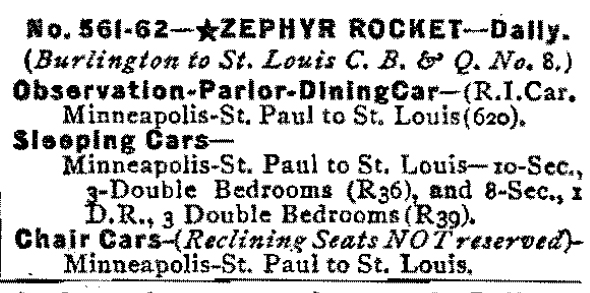
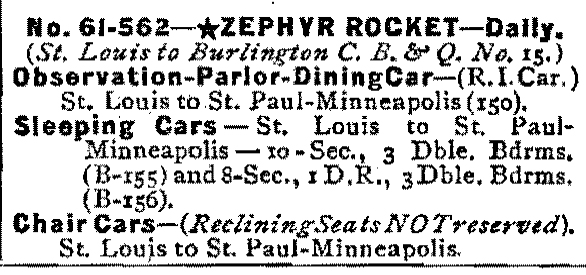
The service on board the Zephyr Rocket was an exercise in unrivaled luxury. Amenities encompassed exclusive seating arrangements for parlor observation (which included full dining service), reclining seats for coach passengers, Pullman sleepers (which, by 1952, included a car with a 10 section/3 double bedrooms and another featuring an 8 section/drawing room/3 double bedrooms), and even personalized porter service. It was a zenith of travel comfort during its operational years.
The Zephyr Rocket covered a distance of approximately 586.5 miles, a testament to the infrastructure prowess of the time and the deft work of engineers who designed and maintained the route.
Today, such a corridor would not even be available as the Rock Island segment was largely abandoned following its 1980 liquidation.
Timetables (1952)
Rock Island
The last run of the Zephyr Rocket, however, was on April 8, 1967. The phasing out of this iconic train was an effect of declining US passenger railway services, a growing preference for automobile transportation, and a shift in market needs and realities.
From St. Louis, the train would hurtle northwards to Burlington on the CB&Q tracks. From there, it switched onto the Rock Island lines that led it up towards the Twin Cities. The southern segment south of Burlington closely followed the Mississippi River much of the way.
On the Burlington, the Zephyr Rocket made a proud parade through iconic locations such as Fort Madison and Keokuk, Iowa. It then passed through Missouri locations like Hannibal and West Alton before arriving in St. Louis
Switching onto Rock Island tracks, it wove through Iowa at such locations as Mediapolis, West Liberty, Cedar Rapids, Cedar Falls, and Waterloo. The train then crossed over into Minessota, making a steady impact in cities like Albert Lea, Owatonna, and Northfield before arriving in Minneapolis/St. Pauls.
Architecturally, the sleek lines and seamless integrations of the passenger cars showcased one of the Budd Company's best designs.
The train featured a striking silver and red color scheme that made it visually appealing, fully reflecting the "Rocket" brand name. On the Burlington, the diesels were typically led by stainless steel E5s or newer variants like E7s and E8s adorned in silver paint.
Pullman-Standard, another titan of railcar manufacture, was involved in creating railroad sleeping cars for different services, and it was no different in the case of the Zephyr Rocket.
The distinct look of the EMD diesels at the helm was distinctive of the efficiency, speed, and reliability that the Zephyr Rocket represented. They became the symbol of an era where passenger service railroads pushed the boundaries of what speed, comfort, and safety could be on long-distance trips.
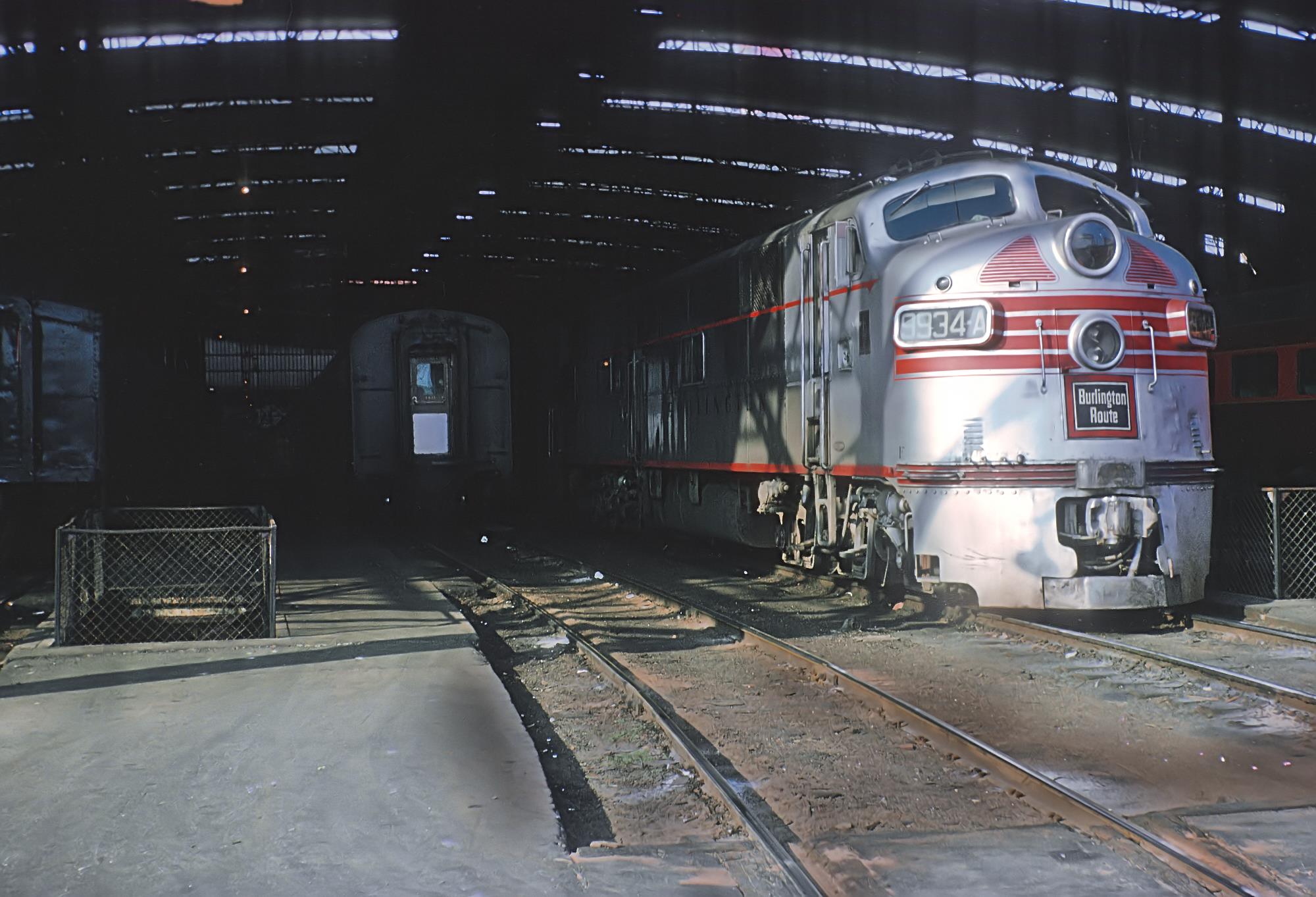 Burlington E7A #9934A awaits depature from the train shed at St. Louis Union Station with the "Zephyr Rocket" in April, 1963. Rick Burn photo.
Burlington E7A #9934A awaits depature from the train shed at St. Louis Union Station with the "Zephyr Rocket" in April, 1963. Rick Burn photo.The Zephyr Rocket's 565-mile journey was completed in approximately 15 hours. Most of the journey occurred overnight, departing each city at 5 pm and arriving at its final destination the following morning at 8 am. Elegance, speed, and service quality were pledges it reliably delivered each day of operation.
The decline and eventual retirement of the Zephyr Rocket was not a lone event. It was a part of a broader shift in transportation beginning in the late 1950s, and by the 1960s a considerable downturn in long-distance rail passenger services was quite evident in the US.
A part of the Zephyr Rocket's discontinuation also lies in the competitive pressures from emerging airlines and the growing popularity of automobile transport, factors which made train services less enticing for the average American traveler.
In its nearly two decades of service, the Zephyr Rocket bundled unprecedented luxury, convenience, and speed together. Past its physical presence, it still resides in heart of the American rail enthusiast, preserved in photographs, model trains, and stories, narrating rail history to modern generations.
Burlington Timetable (1952)
Final Years
Despite its closing chapter, the legacy of the Zephyr Rocket continues to light up rail history. Its tale of grandeur and dedication to service has been preserved in literature, movies, and more recently in the world of model railroading.
At its peak, the Zephyr Rocket served the key business and travel corridors of St. Louis and Minneapolis. This route and its services registered a wealth of human experiences, facilitating bonds and nurturing connections.
In conclusion, the Zephyr Rocket remains an inextinguishable flame in America's railroad history. Although its physical footprint has disappeared, its wanderings still continue in every rail enthusiast’s heartbeat. Its legend, along with the names of Rock Island, Burlington, and the Budd Company, will persist, exemplifying the golden era of travel on the tracks.
Sources
- Overton, Richard. Burlington Route: A History Of The Burlington Lines. New York: Alfred A Knopf, Inc. 1965.
- Schafer, Mike and Welsh, Joe. Streamliners, History of a Railroad Icon. St. Paul: MBI Publishing, 2003.
Recent Articles
-
Missouri's 'Wine Tasting' Train Rides
Dec 12, 25 04:13 PM
The fusion of scenic vistas, historical charm, and exquisite wines is beautifully encapsulated in Missouri's wine tasting train experiences. -
Minnesota's 'Wine Tasting' Train Rides
Dec 12, 25 04:07 PM
This article takes you on a journey through Minnesota's wine tasting trains, offering a unique perspective on this novel adventure. -
Texas - Murder Mystery - Dinner Train Rides
Dec 12, 25 01:06 PM
Here’s a comprehensive look into the world of murder mystery dinner trains in Texas.

